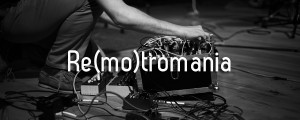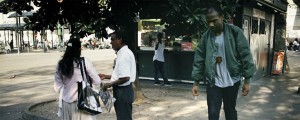Whilst his roots are in the downtown New York experimental music scene, recently Christian Marclay has become more widely recognized for his ambitious film and video works. ‘Musical’ concerns have remained, however; Video Quartet (2002) is a four-screen installation in which musical scenes from a vast array of filmic source material is mixed and juxtaposed to effectively create a new work (predictable reference to Marclay’s early adoption of hip-hop methodology goes here). The Clock (2010), while less overtly musical is nevertheless greatly concerned with rhythm and time, being, as it is, a functioning 24-hour clock produced entirely from innumerable cut-ups of time-centric sequences from film and television.
Everyday, then, unites these two aspects of Marclay’s oeuvre, music and video, being a video work that functions as a score, of sorts, for a group of improvising musicians to respond to. In this case the improvisers in question are a bunch of familiar names from the British jazz/improv/chin-stroking scene, including Steve Beresford on piano and peculiar electronics and the ubiquitous John Butcher on various reed instruments, as well as Marclay himself on the wheels of steel.

The film has its own soundtrack too, and this is incorporated into the performance, starting with the opening sequence, a flurry of knocks on doors and ringing doorbells that build up, rhythmically, a sense of urgency to GET THINGS STARTED. A lot of the film employs these sorts of tactics to create growing tension – on entering the venue the audience is greeted by a looped film of a pensive hand clutching at closed curtains, as if an actress is nervously planning her grand entrance. In the film itself, things are much more pro-active, perhaps a deliberate ploy to antagonize the musicians.
In one sequence, a girl chewing gum blows a bubble, a scene which is then looped so the bubble expands and contracts, constantly threatening an explosion but… Later a run of split screen shots of needles hitting the groove are looped and ‘scratched’ back and forth as if an alcoholic DJ with serious DTs is resolutely failing to put a record on, the musicians responding in kind with a run of splenetic, stuttering outbursts, before as one stopping, perfectly, as the needle is taken off. An obvious move maybe, but still a pretty nifty one.
It’s something worth noting about the piece, and Marclay’s work in general; high art this certainly is, but it’s also a lot of FUN, as entertaining as it is edifying. Everyday has its fair share, trombonist Alan Tomlinson at one point performing a theatrical solo/’duo’ with a filmed violin which is definitely a lot funnier than it’s going to sound when writing a review. Even better is a series of scenes of drums being hit that builds up to a cacophony of marching bands. At some point the viewer begins to suspect that, even taking into account the combination of film soundtrack and musicians on stage, there’s still a lot of noise going on. So you look around to discover that yes, an actual marching band is parading through the auditorium.

After that things quieten down. Butcher gets a solo playing against a scene wherein a sleeper must not be awoken, which again plays out a lot funnier than it reads. As the music recedes, variations of ‘The End’ roll on the screen. The process, or observance, of time passing has been a constant reference point during the performance, but it could’ve been half an hour, or three, it’s as if time were suspended. And then: fade…to…black.
(Christian Marclay’s Everyday performance took place last Saturday as part of this year’s Ether Festival)



















